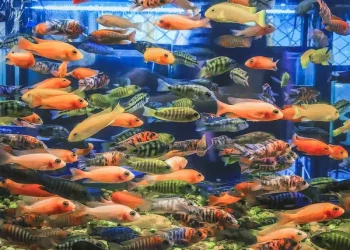Lungfish, as the name suggests, are a unique group of fish that possess the ability to breathe air, allowing them to survive in environments with low oxygen levels. They are found in freshwater habitats such as rivers, lakes, and swamps in Africa, South America, and Australia. Lungfish are known for their unusual appearance, and their anatomy has adapted to their unique environment.
One of the most notable features of lungfish is their elongated body shape. They have a cylindrical body that tapers towards the tail, and their skin is covered in a layer of mucus to keep them moist. The skin can range in color from dark brown to grey or even green, and it is often speckled with spots or patterns. Their scales are thin and flexible, making it easy for them to move through the water and navigate around obstacles.
The most distinctive feature of the lungfish is their lung-like organ, which allows them to breathe air. This organ is located in the throat, and it is connected to the fish’s mouth through a tube called the glottis. When the fish surfaces, they gulp air into the lung and extract oxygen from it. The lung is also used to expel carbon dioxide from the body.
Lungfish also have a unique set of fins. Their dorsal fin is long and extends the length of their back, while their anal fin runs along the bottom of their body. Both fins are supported by bony structures, which help the fish to maintain their shape and maneuver through the water. Their pectoral and pelvic fins are relatively small, and they are used primarily for stability and steering.
Another unusual feature of lungfish is their teeth. They have a set of powerful teeth that are used to crush and grind their food. Unlike most fish, which swallow their food whole, lungfish bite off small pieces of food and chew it with their teeth. This allows them to digest their food more efficiently and extract as many nutrients as possible.
In summary, lungfish are an intriguing group of fish with a unique set of adaptations. They have an elongated body shape, flexible scales, and a lung-like organ that allows them to breathe air. Their fins are supported by bony structures, and they have powerful teeth that they use to chew their food. Overall, the lungfish is a fascinating example of how evolution can shape an organism to thrive in its environment.

























